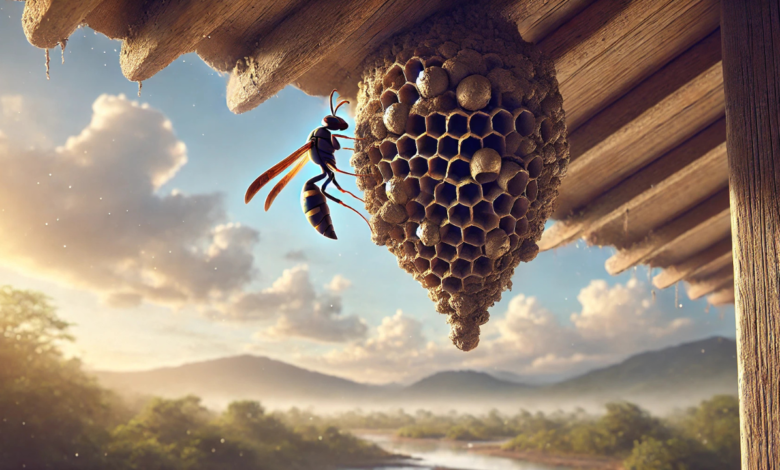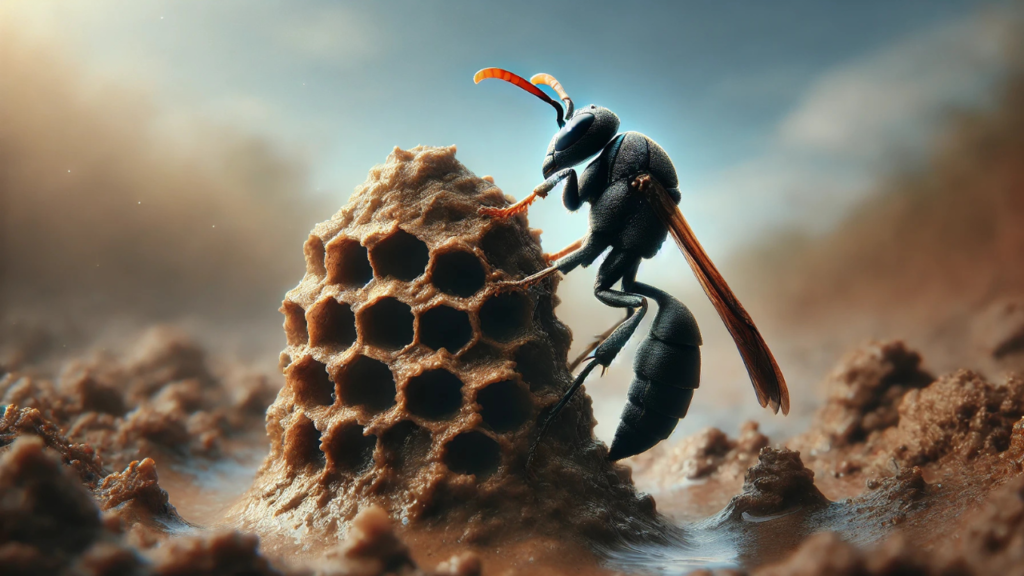The Ultimate Guide to Dirt Dobbers: Understanding and Managing These Fascinating Creatures

Introduction to Dirt Dobbers
Dirt Dobbers, also known as mud daubers, are a group of solitary wasps that play an essential role in ecosystems worldwide. Unlike aggressive social wasps, Dirt Dobbers are generally non-threatening to humans. Their name is derived from their unique habit of building their nests out of mud, which makes them look like a “dobber” or “dabber” as they deposit clumps of Dirt to construct their homes. These nests are often found in shaded areas, such as eaves, porches, or tree branches, providing a haven for their larvae to develop.
While many people fear wasps, Dirt Dobbers are pretty different. These relatively passive creatures are known for their distinct nesting behaviour. Their nests are often seen as a nuisance, but in reality, they are essential to a balanced ecosystem. Their work as pollinators and natural pest controllers can help regulate other insect populations, ensuring a more harmonious environment.
Understanding Dirt Dobbers and their natural behaviour can help alleviate unnecessary fears. The presence of these creatures may signal a healthy yard or garden. This guide will explore their life cycle, their vital role in nature, and how humans can peacefully coexist with these fascinating wasps.
The Life Cycle of a Dirt Dobber
Dirt Dobbers undergo an intriguing transformation throughout their life cycle, which involves several distinct stages. They start as eggs, which the adult wasp lays in a carefully prepared nest. These nests are often made of mud, which the wasp collects using its mandibles and mixes with saliva to form small, protective compartments. Each compartment houses a single egg, ensuring that the developing larvae have plenty of room to grow.
Once the egg is laid, it hatches into a tiny larva. This larva feeds on the paralyzed insects that the adult Dirt Dobber hunts and brings back to the nest. These prey insects, usually spiders, are incapacitated by a sting and carefully placed inside the nest. The larvae feed on the spiders while slowly growing and developing into pupae. The pupal stage is critical in their development, where the larvae transform into adult wasps. The pupae remain dormant in their nests until they emerge as fully developed Dirt Dobbers.
The adult Dirt Dobber is typically sleek and black, with elongated bodies and a distinctive narrow waist. These wasps are not known to be aggressive and tend to focus on building their nests and hunting for food rather than interacting with humans. Their non-social nature and passive behaviour make them one of the least bothersome wasp species. Their primary role is to search for spiders, which they paralyze and leave alive for the larvae to consume once they hatch.
The Role of Dirt Dobbers in the Ecosystem

Dirt Dobbers may seem like an insignificant presence in nature, but they serve several essential functions that contribute to the health of ecosystems. One of the most notable roles they play is as natural pest controllers. Dirt Dobbers help regulate spider populations in the wild by hunting and paralyzing spiders. Although many people find spiders undesirable, they are an essential part of the food chain, and controlling their population helps maintain balance in ecosystems.
Moreover, Dirt Dobbers are essential pollinators. Although they are not as efficient as bees, dirt dobbers contribute to pollination by visiting flowers as they forage for food. Their visitations help transfer pollen from one flower to another, supporting plants’ reproductive processes. This mainly benefits plants that rely on insect pollination for fruit and seed production.
The presence of Dirt Dobbers can also enhance soil health. As these creatures create their nests out of mud, they can improve soil conditions around their nesting sites. Their nesting habits allow them to aerate the soil, which promotes healthier plant growth. This indirect contribution to soil health can have lasting effects on the surrounding flora and fauna, highlighting these wasps’ vital role in nature.
Common Misconceptions and Facts About Dirt Dobbers
Despite their essential role in the ecosystem, Dirt Dobbers are often misunderstood, with many misconceptions surrounding their behaviour and nature. One of the most common myths is that these wasps are dangerous and aggressive. In reality, Dirt Dobbers are solitary wasps that rarely sting. They use their stingers primarily for subduing their prey, not for defence. Most people who encounter Dirt Dobbers are unlikely to be stung, as these wasps have little interest in humans and will often fly away if disturbed.
Another misconception is that Dirt Dobbers are a nuisance to gardens or homes. While their nests may appear unsightly, Dirt Dobbers typically do not cause harm to plants or structures. Their mud nests can sometimes be seen on the sides of buildings or under roof eaves, but these are generally harmless. The insects they collect for their larvae, such as spiders, are not a threat to humans and help to reduce other insect populations that might otherwise become pests.
Additionally, some people may be concerned about Dirt Dobbers invading their homes. However, it is essential to note that these wasps build their nests in natural outdoor environments rather than inside human dwellings. If a nest is found in an inconvenient location, it is often easy to relocate it by carefully removing the mud structure and placing it in a more suitable area.
Managing and Coexisting with Dirt Dobbers
While Dirt Dobbers are beneficial creatures, they can sometimes be found building nests in places where they are unwanted, such as near doorways or windows. In these cases, it is essential to know how to manage the situation without causing harm to the wasps. One option is to gently remove the nest and relocate it to a safer, less intrusive location. Since Dirt Dobbers are solitary wasps, they do not need a large colony to thrive, and the nest can be relocated without much disturbance to the wasp population.
If you choose to leave the nest intact, respecting Dirt Dobbers’ role in your ecosystem is essential. They help control pest populations and are excellent pollinators, so allowing them to remain can benefit your garden or yard. Furthermore, Dirt Dobbers are unlikely to pose any serious threat, as their passive nature means they typically ignore human presence unless provoked.
Consider implementing natural deterrents to keep dirt dobbers from nesting in unwanted spaces in areas with abundant nests. Simple solutions include sealing cracks and crevices around windows, doors, and roofs to prevent these creatures from building nests inside. Planting certain herbs or flowers that repel wasps may also help keep Dirt Dobbers at bay.
Conclusion
Dirt Dobbers are fascinating creatures that contribute significantly to maintaining ecological balance. Despite their intimidating appearance, these wasps are not dangerous to humans and are, in fact, essential players in the natural world. By controlling pest populations, pollinating plants, and enriching soil health, Dirt Dobbers provide invaluable benefits to gardens, yards, and the wider environment.
Understanding and respecting these creatures is key to coexisting with them peacefully. Rather than seeing them as a nuisance, it’s essential to recognize their vital role in nature and support their presence in your yard. Whether you leave them undisturbed or carefully relocate their nests, Dirt Dobbers are creatures worth appreciating for their environmental contributions.
FAQs about Dirt Dobbers
Q1: Are Dirt Dobbers dangerous to humans?
No, Dirt Dobbers are not dangerous to humans. They rarely sting and are generally non-aggressive.
Q2: What do Dirt Dobbers eat?
Dirt Dobbers primarily feed on spiders, which they paralyze and use to feed their larvae.
Q3: How can I tell if a Dirt Dobber nest is active?
An active nest will often have visible mud compartments, and you may see adult Dirt Dobbers coming and going from the nest.
Q4: Can Dirt Dobbers harm my garden or plants?
No, Dirt Dobbers do not harm plants. They may even help by reducing spider populations that could damage plants.
Q5: What should I do if I find a Dirt Dobber nest near my home?
If the nest is in a convenient spot, leave it undisturbed. If it is in a troublesome location, consider relocating it safely.
Q6: Do Dirt Dobbers sting?
Dirt Dobbers can sting, but they typically use their stinger to paralyze prey, not to defend themselves against humans.
Q7: Are Dirt Dobbers beneficial to my lawn or yard?
Yes, Dirt Dobbers help control pest populations and contribute to pollination, making them beneficial for your yard.
Q8: How do I prevent Dirt Dobbers from building nests near my property?
Seal any cracks and crevices around your home, and consider using natural deterrents to keep them away
You May Also Read: https://usabuzzwire.com/social-media-girls/
